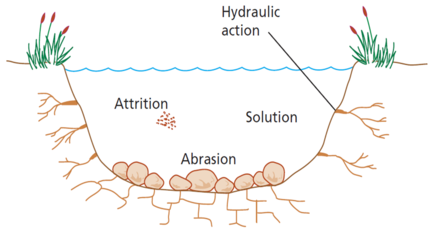Erosion as Art
This EarthCache is intended as an easily accessible and simple one, to demonstrate the way water in a river can erode the rock it passes over. It also will show you how certain erosion does more than simply create a channel for water to pass through but can create unexpected sculptures in the rocks which are very attractive and photogenic. This EarthCache will allow you find out why the rocks are now shaped as they are. This is a simple EarrhCache which requires no previous geological knowledge. Simply reading the information below will tell you all you need to know to answer a few straightforward questions in order to log your find. Remember there is no box hidden at the coordinates. The falls are easily accessed by following a well signed footpath from near the war memorial in Glencoe.
River Erosion
Erosion is the breaking down of material by an agent. In the case of a river, that agent is water. The water can erode the river’s channel and the river’s load. A river’s load is bits of eroded material, generally rocks that the river transports until it deposits its load.
A river’s channel is eroded laterally and vertically making the channel wider and deeper. The intensity of lateral and vertical erosion is dictated by the stage in the river’s course - essentially, in the upper stage of the river’s course (close to the source of the river) there is little horizontal erosion and lots of vertical erosion. In the middle and lower stages vertical erosion is reduced and more horizontal erosion takes place.
Types of River Erosion
There are four key types of erosion that take place in rivers and these are outlined below.

Hydraulic action
The pressure of water breaks away rock particles from the river bed and banks. The force of the water hits river banks, and then pushes water into cracks. Air becomes compressed, pressure increases and the riverbank may, in time collapse. Where velocity is high e.g. the outer bend of meaner, hydraulic action can remove material from the banks which may lead to undercutting and and river bank collapse. Near waterfalls and and rapids, the force may be strong enough to work on lines of weakness in joints and bedding planes until they are eroded.
Abrasion / Corrasion
The sediment carried by a river scours the bed and banks. Where depressions exist in the channel floor the river can cause pebbles to spin around and turn hollows into potholes.
Attrition
Eroded rocks collide and break into smaller fragments. The edges of these rocks become smoother and more rounded. Attrition makes the particles of rock smaller. It does not erode the bed and bank. Pieces of river sediment become smaller and more rounded as they move downstream.
Corrosion / Solution
Carbon dioxide dissolves in the river to form a weak acid. This dissolves rock by chemical processes. This process is common where carbonate rocks such as limestone and chalk are evident in a channel.
Logging Requirements (Questions to Answer)
As this is an EarthCache there is nothing hidden here to find, please don't search. Instead, you must answer a number of questions in order to log your find. You are not expected to have any previous knowledge of geology or rocks, so please do give it a try. All the information you need to answer the questions is found by reading the information above and I only ask you make an attempt at answering the questions. If you don't send in any answers at all, your log may be deleted.
Please note, this is an observational EarthCache. This means you should read the information in the listing and then look for actual evidence that matches with the descriptions. No hypothetical guesses are required so please only base your answers on what you see.
Question 1
Please look upstream of the falls and downstream of the falls and describe how the river is different before and after the falls compared to the river in the falls. I'm interested in hearing about the width, flow rate, pebbles and anything else you observe.
Question 2
Now turn your attention to the ways river erosion occurs using the information in the listing. Of the four choices outlined, which do you think is the main cause of the sculpted river erosion you see in front of you here?
Question 3
Why do you think the answer you have come up with in question 2 may be a particularly strong erosion type here? Your observations in question 1 will help you here.
Question 4
Finally, please observe the various rock art here caused by river erosion. Describe the one you like the best and explain very briefly how you think it was formed.
Optionally, please include a photo if you wish but please take it from a distance; avoid any photos showing too much detail that might be spoilers. Thanks.
Thank you for visiting the Kilday Falls